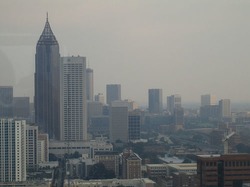EPA wants stricter smog pollution rules to protect public health
 The Environmental Protection Agency proposed a stricter new standard yesterday for smog-causing pollution in an effort to better protect people from health problems including asthma and heart disease.
The Environmental Protection Agency proposed a stricter new standard yesterday for smog-causing pollution in an effort to better protect people from health problems including asthma and heart disease."EPA is stepping up to protect Americans from one of the most persistent and widespread pollutants we face," said EPA Administrator Lisa Jackson. "Using the best science to strengthen these standards is a long overdue action that will help millions of Americans breathe easier and live healthier."
The proposal targets ground-level ozone, the primary constituent of smog, by lowering the acceptable standard of 75 parts per billion (ppb) adopted by the Bush administration in 2008 to between 60 and 70 ppb. The chemical is formed when emissions from industrial facilities, power plants, landfills and motor vehicles react with sunlight.
Children are at the greatest risk from ozone because their lungs are still developing, they're more likely to be active outdoors and they're more likely to have asthma. Adults with lung disease and older people are also particularly sensitive to the pollutant.
"This is exactly what states and localities have advocated for 30 years," S. William Becker, executive director of the National Association of Clean Air Agencies, told the New York Times. "This will not be easy to achieve, whichever number the EPA ultimately chooses, but it's a decision that will ensure that public health is protected with an adequate margin of safety."
The new standard is based on a unanimous recommendation from EPA's Clean Air Scientific Advisory Committee Ozone Review Panel, which recommended the stricter limit in 2006 based on evidence showing adverse health effects from the earlier 80 ppb standard set in 1997. The CASAC criticized the Bush administration's standard for failing to provide an adequate safety margin.
Not surprisingly, though, some polluters are unhappy with the proposal. The American Petroleum Institute, for example, called the EPA's move "an obvious politicization of the air quality standard setting process that could mean unnecessary energy cost increases, job losses and less domestic oil and natural gas development and energy security."
EPA estimates that the costs of implementing the standard would range from $19 billion to $90 billion. But it calculates that the proposal would yield health benefits including fewer hospital visits and missed work days valued at between $13 billion and $100 billion.
More than 300 counties -- many of them in the Southeast and along the Gulf Coast -- already violate the current standards. In North Carolina, for instance, more than half of the state's 100 counties could fail to meet the new standard.
In Texas, the stricter standard would almost double the number of counties that are out of compliance. That's not sitting well with Gov. Rick Perry (R), who said he might take EPA to court over the change.
EPA is accepting public comments on the proposed rule. It will also hold three public hearings on the proposal, including two on Feb. 2 in Arlington, Va. and Houston.
(Photo of downtown Atlanta shrouded in fog by Ben Ramsey via Flickr.)
Tags
Sue Sturgis
Sue is the former editorial director of Facing South and the Institute for Southern Studies.
